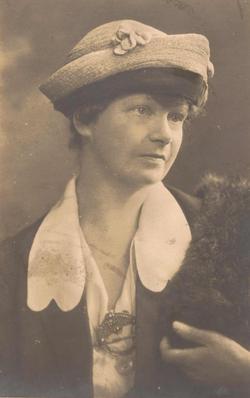Alice Cashel facts for kids
Quick facts for kids
Alice Cashel
|
|
|---|---|
 |
|
| Born |
Alice Cashel
17 July 1878 Parsontown, County Offaly, Ireland
|
| Died | 22 February 1958 (aged 79) Galway, Ireland
|
| Nationality | Irish |
| Other names | Miss Armstrong |
Alice Mary Cashel (born 17 July 1878 – died 22 February 1958) was an important Irish woman. She was a strong supporter of Irish independence. She worked as a local politician, known as a County Councillor, and also served as a judge. Alice was one of the people who helped start the Cork branch of Cumann na mBan, a women's organization that played a big role in Ireland's fight for freedom.
Contents
Early Life and Education
Alice Cashel was born on 17 July 1878 in a town called Birr, County Offaly. Back then, it was known as Parsonstown. Her father, Blennerhassett Cashel, was a station master from County Tipperary. Her mother was Maria Agnes Lyons from County Cork.
Alice became a teacher. She also studied hard to earn a degree from the Royal University of Ireland. In 1895, her sister Agnes Cashel married James O'Mara, who later became a well-known politician in the Sinn Féin party.
Working for Irish Independence
Alice Cashel joined the Sinn Féin party in 1907. This party worked for Ireland to become an independent country. She was very active in Cork, where she lived. Around 1914, she helped create the Cork branch of Cumann na mBan with Annie McSwiney. She also helped set up the Cork branch of the Irish Volunteers.
The Easter Rising and a Secret Mission
In 1916, Alice was living in Limerick. She learned about the Easter Rising when she visited a friend, Sean Hegarty. This was a major rebellion against British rule in Dublin.
Alice was given a secret task. She was told to get cars using a different name. These cars were meant to pick up weapons arriving from a ship called the Aud in Kerry. However, the plan changed when Roger Casement was arrested and the weapons were lost. So, the cars were not needed.
While the Rising happened in Dublin, Alice waited for new orders. After the Rising, she got an important report from Sean Hegarty. She had to memorize it and destroy the original paper. Then, she traveled to New York City in the United States. There, she successfully wrote out the report again and gave it to John Devoy, an Irish-American leader. Alice returned to Ireland in January 1917 and continued teaching.
Organizing and Being on the Run
By 1918, Alice had moved to Galway. She became an organizer for Cumann na mBan in the area. She helped set up new branches, including one in Newry. She also traveled with important leaders like Éamon de Valera and Seán MacEntee to set up branches all over Donegal.
Alice also helped with elections in Tyrone, Monaghan, and Cavan. During one meeting, the police raided it and destroyed the stage she was on. Because the police wanted to arrest her, Alice had to hide and move around for several months to avoid capture.
Her brother-in-law, James O'Mara, became a member of the first Dáil Éireann (Ireland's independent parliament) in 1919. Later, he asked Alice to manage his oyster business for a while. This was also a way for her to stay out of sight.
The local police knew who Alice was. They even thought she might be bringing guns from America. Her house was searched, but the documents they found were mostly about her studies on holy wells. She was arrested and held in jail for about a week during her time in Galway.
A Leader in Local Government
Because she had been in jail, Alice was chosen to join the Galway County Council in June 1920. This meant she became a local politician. She was also chosen for the Clifden District Council. Very quickly, on 19 June 1920, she was elected as the Vice-Chairman of the Galway County Council. She held this important position until 1921. By March 1921, she was even acting as the Chairman because the original Chairman had been arrested.
Alice also helped restart a local group of the Irish Volunteers. She gave them tasks, including trying to control illegal activities in the area.
Escaping and Returning
Eventually, her home was raided by the Black and Tans, a special police force. Alice managed to escape and went to Dublin. From there, her family's business sent her to France. In Paris, she was able to talk with Erskine Hamilton Childers, another important Irish leader.
Alice returned to Galway and disagreed with the County Council's support for the Anglo-Irish Treaty. This treaty created the Irish Free State but also divided Ireland. Alice was arrested in January 1921 when she tried to attend a council meeting. She was held in jail until 25 July 1921.
After her release, Alice moved to Dublin. She worked for Erskine Childers' office. To avoid being recognized, she used the name "Armstrong." She mostly worked in offices that created messages and information for the public until the treaty was signed.
Serving as a Judge
Alice Cashel was also chosen to be a judge in the Dáil Courts. These were courts set up by the independent Irish parliament. She received a lot of votes at the meeting where judges were chosen. She served as a "Parish Justice" in the Connemara area, helping to settle local disputes.
Later Life
In 1935, Alice Cashel wrote a book for young adults. It was a popular story used in Irish schools. The book was set just before and during the 1916 Easter Rising, following a family in the west of Ireland.
Alice lived in Roundstone, County Galway. She passed away on 22 February 1958 in Galway and was buried with honors on 25 February 1958.
Images for kids


